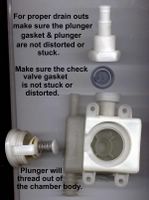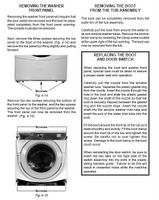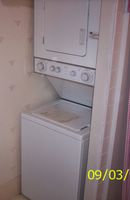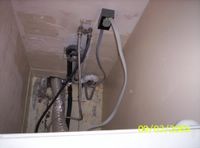Monthly Archives: September 2005
Dishwasher won’t run; no power to dishwasher; dishwasher dead; dishwasher no-op; dishwasher repair
Went on a dishwasher service call the other day. Complaint was that the dishwasher was completely dead. The customer had already verified that the circuit breaker wasn’t tripped.
First thing I always do on a dead dishwasher complaint is to verify that power is available at the power junction box in the dishwasher. I removed the kickplates, then open the junction box cover and, SHAZAAM! that’s what I saw. It’s a wonder the breaker didn’t trip!
Invariably, I get asked, “What caused those wire connections to burn?” Loose electrical connections generate heat– these wire nuts were probably not installed correctly and loosened enough over time to cause the connection to burn. In this case, the connections were contained by a grounded metal box, so there was little fire danger.
To learn more about your dishwasher, or to order parts, click here.
Unveiling a New Mac iBook: A voyeuristic peek into a disturbing moment in the life of a certifiable geek.
GE / Kenmore Dishwasher Check Valve Assembly; No-Drain or Poor Draining; Check Valve; dishwasher repair

GE / Kenmore Dishwasher Check Valve Assembly; No-Drain or Poor Draining = Clean Out Check Valve and/or Replace Flapper Gasket (click to enlarge). Located at the very back in the middle – take off the cover.
Parts Link: Piston Assembly for Check Valve
To learn more about your dishwasher, or to order parts, click here.
Whirlpool / Kenmore Calypso Washer Component Access Diagram (valve, pump, motor, washer plate, u-joint, pressure switch, etc.); washer repair

Whirlpool / Kenmore Calypso Washer Component Access Diagram (click to enlarge)
To learn more about your washing machine, or to order parts, click here.
Whirlpool Duet Washer: how to remove the front access panel; how to remove the boot (bellows) assembly from the tub, how to replace the boot (bellows), washer repair

Whirlpool Duet / Kenmore HE3t Washer: how to remove the front access panel; how to remove the boot (bellows) assembly from the tub, how to replace the boot, how to replace the door switch. (click to enlarge)
Parts Link: Front Bellows Seal (boot)
To learn more about your washing machine, or to order parts, click here.
Background Information on LG, Siemens, and Samsung Appliances for Consumers; appliance reviews
One of the Master Appliantologists at the Samurai School of Appliantology, TomBBY, wrote up a nice backgrounder piece on LG, Siemens, and Samsung appliances. If you’re in the market for new appliances, you need to read this!
____Original Message_____
From: TomBBY
Date: 2005-09-28 12:35:49
Subject: LG and Siemens AppliancesI have noticed reading your site that you had no listing or information for a couple of products we carry, so I thought I might share a little wisdom with you. 🙂
Siemens washers, dryers, ranges and OTR microwaves are carried by Best Buy, and quite possibly some others. These majors are produced by Bosch of America (in the Carolinas, I believe), while the OTR is manufacturered for them by LG (Lucky-Goldstar).
LG and Samsung are mostly coming from South Korea (the ones from North Korea tend to explode, so we don’t buy them! 8-0 ), and the BEST of the two is definitely the LG. We have only had two LG refrigerators in 2+ years come in with an electrical problem, and it didn’t affect the way they cool. 99.9% of the problems we have with LG is scratch and dent out of the box. Otherwise, they are one of the most trouble free appliances I have ever sold. I actually get customers returning to the store to thank me for selling them this appliance!
The LG laundry products are practically bullet-proof. The only problem we’ve encountered so far, is a door buffeting problem, that was fixed with a free kit of four shim/washers for the inside latch – to bring the door closer to the drum. That was only in the early units – no later units have had even that problem! If you compare the LG washer/dryer to the Whirlpool Duet (which we also sell), it makes it very difficult to sell a Duet. Even with Whirlpool’s name recognition, the LG laundry pair is just such a better performer (and superior in design) than the Duet. LG really made these machines well.
The only loose canon in the whole kitchen group in the Siemens dishwasher, which although VERY quiet (runs at 48 dbs), is decidedly being produced in the same plant as the Bosch – or at least with the same design. However, the Bosch units list a 42db rating over their Siemen’s counterparts. The LG is also rated at 48db, (and ALSO looks suspiciously like the Bosch!) but with it’s sealed sides it’s hard to believe that it produces much noise over a low hum. I have had customers contact me after installing one of these (LG) in their home, remark at it’s low water usage, easy control, and virtually no noise – even when installed into an island!
Samsung refrigerators are doing MUCH better than they did when they first appeared on the MAJAPS scene, but they are still not up to the quality of a Whirlpool or LG product. While they make their own refrigerators (and I believe their own “special design” OTR microwaves) their ranges and dishwashers are CLEARLY built by Maytag. However, since Maytag has left a bad taste in BBY’s mouth, so to speak, the only Maytag built products you will now find on our floor are Hoover products.
If you look hard enough, you will notice that Sears is using both Samsung and LG designs/builds for their Kennmore OTR line! You will also notice that the LG design is being used for Kennmore’s Trio (French door style) refrigerators, as well as Amana.
Thanks, Tom!
Washing Machine Diagnostic and Repair Guide; washer repair; washing machine repair
| Washing Machine Diagnostic & Repair Guide | |
| Problem | Possible Causes |
| EEK! My washer is leaking! |
|
| The washer doesn’t spin or, if it does, it’s real sluggish. |
|
| It fills OK, it just won’t agitate. |
|
| It doesn’t agitate or spin. |
|
| "Fool thing won’t pump out and I got a tub full of stinky water in the washer. I’m gonna die! EEEK!" |
|
| It sounds like a helicopter’s taking off and the whole house shakes when the washer goes into spin. |
|
| The clothes are still sopping wet at the end of the cycle and take forever to dry. |
|
| "That washer put oil spots all over my clothes. I’m gonna sue!" |
|
| "That horrible washer ate holes in my clothes! I’m gonna die!" |
|
| Clothes are still soapy at the end of the cycle. |
|
| I don’t get no cold water in my washer. |
|
| The washer is completely dead. |
|
Repairing a Melted Hole in a Dishwasher; dishwasher repair
Annisa McAllister wrote:
Frigidare Gallery Model #GPDB998JC0. Bracket supporting heating element became a free spirit and allowed the heating element to melt a 3-inch long little trench in the bottom of the tub. Don’t think it melted a hole, but pretty close. Can I repair with some type of epoxy, ect. ?? Please help restore my kitchen karma….Thanks !!!
_______________________________
Message sent from IP: 70.178.106.11
Not to worry, my leetle grasshopper, your karma is unviolated. I’ve done this repair many times using a good-quality, high-temperature epoxy. In extreme cases where a huge, gaping hole is burned into the tub, you’ll need to pick out the charred and curdled plastic around the wound and cover it with a fiberglass patch, and then slather it with epoxy.
Another technique, easier but with less strength, is to use a duct tape patch on the outside and then slather the epoxy on top of it from the inside. Once the epoxy cures, you can peel away the duct tape.
Appliantology Newsletter for July-August-September 2005
The Appliantology newsletter for July-August-September 2005 is out! Amaze your friends, confound your enemies with your esoteric appliance repair wisdom. To get your very own, FREE, personal copy of this widely-sought after and award-winning journal of appliance enlightenment, just click here.
Happy fixing!
Gas Dryer Fires Up Intermittently; dryer repair
Evie Hump wrote:
I have a question about my dryer. I have a Kenmore that is 3 years old. It has always worked very well, until now. In the last few days the gas does not always turn on. We can start it up, watch what we believe to be the glow plug light up and maybe 75% of the time the gas will start. The other times it does not and the glow plug goes off and after a bit it will try again. Most times it will not heat back up again. Any suggestions!
Thanks
_______________________________
Message sent from IP: 69.212.200.56

Turn on gas dryer,
flame comes on only sometimes.
Replace valve coils.
GE or Hotpoint Dishwasher Hums but Doesn’t Run; dishwasher repair
stvsue wrote:
I just found your site and fixed my dishwasher thanks to your info!
You provided a picture showing the simple task of giving the fan on the motor a twirl to unstick it and…Yahoo! it worked! Thanks again!_______________________________
Message sent from IP: 4.235.84.109
Thanks for your comments! For the benefit of others reading this, the GE dishwasher repair pearl you found is here.
BTW, I’ve noticed that Yahoo seems to be giving much better search results than Google lately. Is King Goo-Goo slipping (*gasp*)?
Roper Dryer Won’t Shut Off; dryer repair
melanie wrote:
Oh noble Samurai, how I love your website. It has already helped me fix my washer, now for the dryer….
Roper model REX3615EW1. Dries and dries, but never stops. Does not matter if it’s on timed dry or auto sense dry….goes and goes and goes…dries the clothes great and then some!
Following your gracious advice, we have THOROUGHLY cleaned the inner and outer duct work. It is directly vented to the outside through a proper vent.
Please help this poor grasshopper, she is truly tired of having to set an alarm clock to remind her to go shut the damn thing off!
_______________________________
Message sent from IP: 64.223.234.101
Ahh, grasshoppah, Bliss Supreme has come upon you this day for the Samurai has received your plaintive plea.
The reason your dryer never shuts off is because the timer has failed. The solution is simple: replace the timer. Easy job, plug n’ chug, a mere single mug on the world-famous SUDs-o-meter.
War Story: Working on a Stack Laundry Unit that Flooded; washer repair

A typical stack laundry unit stuffed into a tight cubby in a bathroom.

Looking behind the stacked laundry unit. Couple things to note: 1) the vent hose, while metallic, which is good, is extremely difficult to disconnect for service and will tend to crimp when the unit is pushed back in place; and 2) since the washer’s water shut off valve is behind the unit and is not accessible for turning off between uses, BOTH fill hoses should be stainless steel braided hoses— that black rubber fill hose is a flood waiting to happen.

This stack laundry unit had flooded– that’s why I was called out to repair it. After pulling the water inlet valve, the reason for the flooding was readily apparent: one of the protective inlet screens had been removed! This is called the cute plumber’s trick. Don’t do it! If you have a problem with scale gunking up the valve and restricting flow FIX THAT PROBLEM! Removing the protective inlet screen just creates another problem.
Is it Worth Replacing a Broken Coupler on a Whirlpool or Kenmore Direct Drive Washer?; washer repair
Tammy wrote:
SA BOM NIM — I have a Kenmore 70 Series heavy duty washing machine, model 110.82873120 which is probably 13 to 14 years old (I say probably because it came with the house when we bought it 5 years ago). I think the transmission coupling has broken, because it hums but doesn’t spin or agitate. Is it worth repairing, being this old? (It has seen light use, only 2-3 loads every week for the last 5 years and I assume similar in the preceding years, as it was owned by a retired couple). What is the expected life of these machines?
Thank you for sharing your great wisdom.
Tammy
______________________________
Message sent from IP: 72.28.19.214
This is one of the best top loading washers made today (Whirlpool is the manufacturer– Sears pays them put a Kenmore label on it). And you’re talking about one of the easiest washer repairs in the appliance world, two mugs on the SUDs-o-meter. Combine this with the fact that the replacement coupler costs less than $15 and it’s a no-brainer: fix your washer!
This page gives complete instructions on how to do this repair and even has a link to the part you need.
As for your question about life expectancy of washing machines, read this.
Go git ’em!


